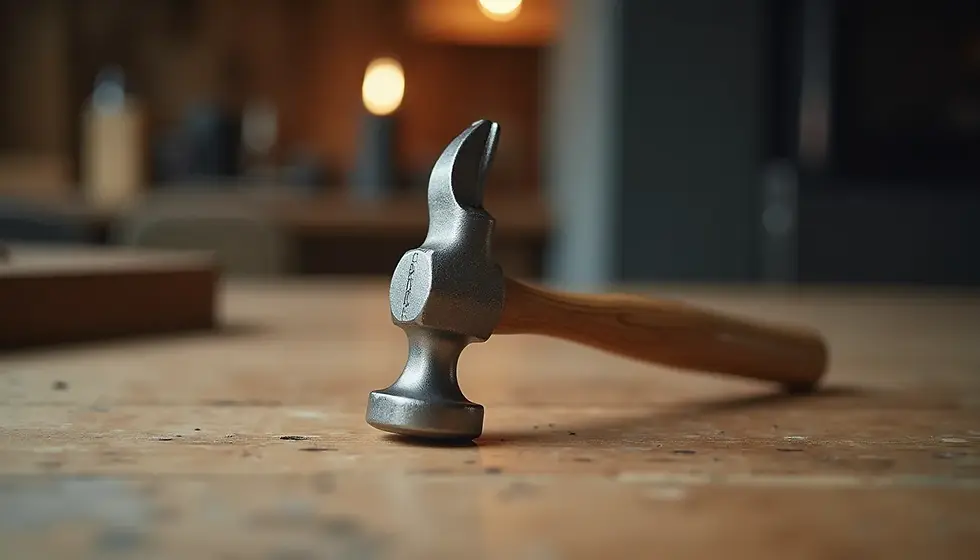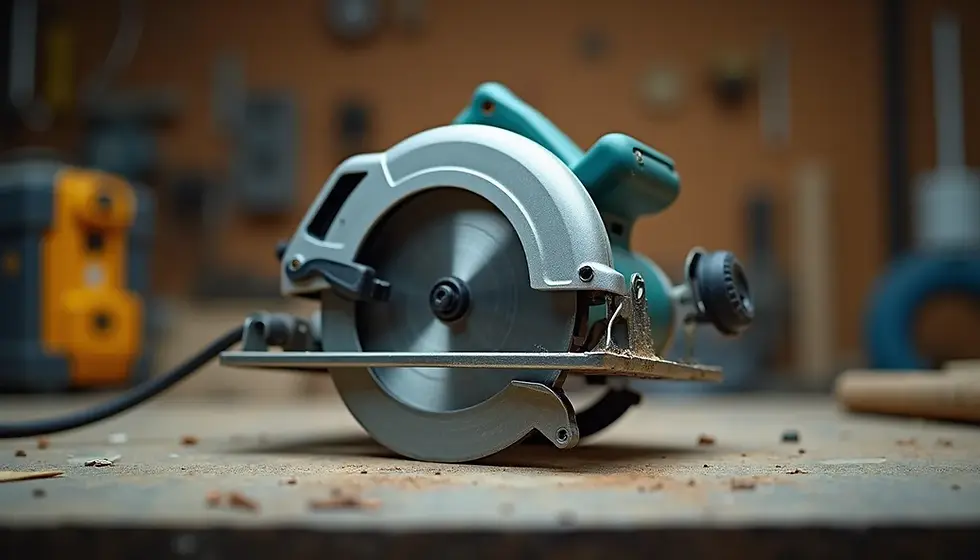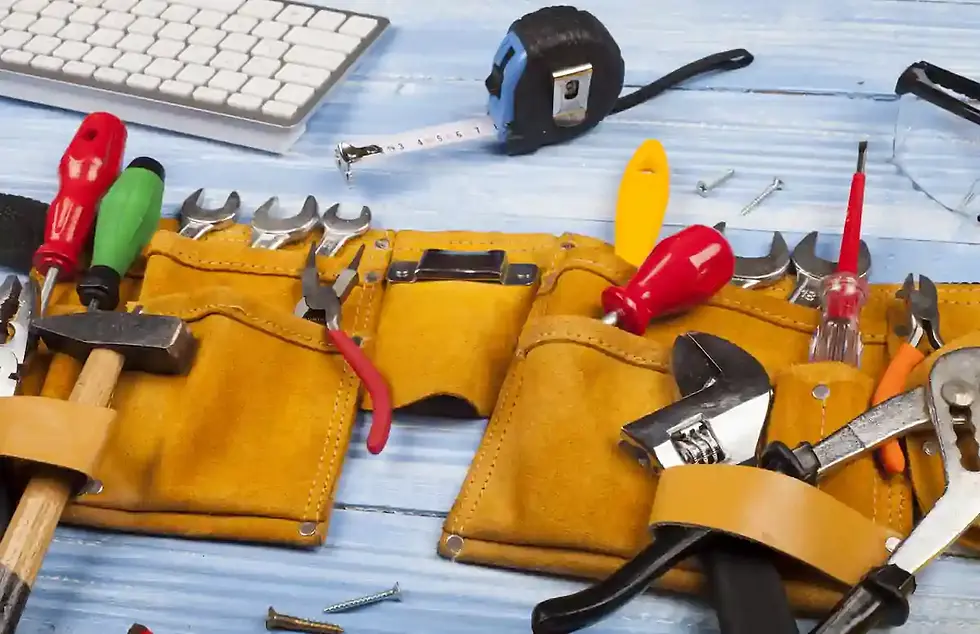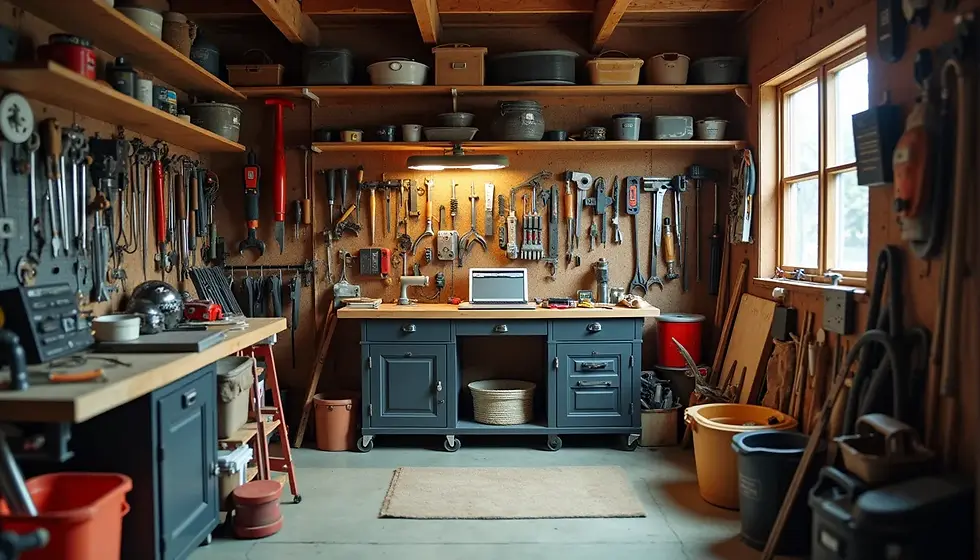Essential Tools for Your Home: The Ultimate Guide
- Mei-Lin Arora

- Sep 3
- 5 min read
Updated: Sep 13
New place, tiny budget, big plans? Perfect. This guide lays out the essential tools for your home—what to buy first, what to upgrade later, and which extras turn “uh-oh” Saturdays into “nailed it” Sundays.
You’ll get step-by-step advice, essential tools checklists, essential garden tools for outdoor chores, and safety habits that keep all 10 fingers attached. 🧰
If you only remember one thing: buy fewer tools, but better ones. “Buy once, cry once” costs less than replacing flimsy gear every six months.

How to think about tools (so you don’t overspend)
A smart kit covers four jobs: measure, cut, fasten, safe. Start with a compact core you’ll use weekly, then layer specialty items as your projects evolve. When in doubt, ask: Will this tool solve three problems I actually have? If not, it’s probably “garage decor.”
Essential Tools for Your Home: The Core Kit
This is the kit you reach for constantly—picture-hanging, assembling furniture, fixing squeaks, stopping leaks, and basic essential home tools tasks.
16–20 oz claw hammer (curved claw, fiberglass or hickory handle)
25-ft locking tape measure (true zero, standout ~9–12 ft)
6-in and 10-in adjustable wrenches
Multi-bit screwdriver (Phillips, slotted, Torx)
Precision screwdriver set (eyeglasses, electronics)
Utility knife with snap blades
Torpedo level (9-inch) and a 24-inch level
Hex/Allen key set (metric + SAE)
Combination pliers and long-nose pliers
Side cutters (flush cutters if you do cable work)
Stud finder (deep scan modes help)
Headlamp or compact work light
Assorted fasteners (wood screws, drywall anchors, picture hangers)
Painter’s tape and duct tape
Super glue (cyanoacrylate) and construction adhesive
Safety glasses and work gloves (fit matters)

Power tools that change the game (start here, then scale)
Start with one battery platform to avoid a zoo of chargers. Cordless tools let you work faster and safer—no trip hazards.
Drill/driver (cordless, brushless) with a 2-pack of 2.0–4.0Ah batteries
Impact driver for long screws/lag bolts (once you try it, you’ll never go back)
Oscillating multi-tool to shave door trim, cut drywall, scrape grout—your renovation Swiss Army knife
Random orbit sander (5") with hook-and-loop discs
Shop vac (wet/dry) for dust, floods, and everything in between
Upgrade path: Circular saw → jigsaw → brad nailer → miter saw. If you’re trimming rooms or building furniture, a miter saw becomes your best friend.
For safe ladder setup (because power tools plus wobbly ladders is… a choice), follow long-standing guidance like the OSHA ladder placement rules and “4-to-1” angle basics via OSHA ladder safety.

Measuring, marking, and layout (accuracy = pro results)
Speed square, combination square, chalk line, and carpenter’s pencil
Stud finder + rare earth magnet (finds drywall screws to confirm studs)
Laser measure (for rooms, trim, flooring, and “will this couch fit?” math)
“Measure twice, cut once” is not a meme. It’s emotional self-defense.
Fastening & fixing (the unsung heroes)
Assorted screw kit (cabinet, deck, and multi-purpose sizes)
Drywall anchors (self-drilling for light loads; toggle bolts for heavy)
Wood glue (PVA) and polyurethane glue (gap-filling, waterproof)
Thread seal tape (PTFE) for plumbing threads
Zip ties and velcro cable wraps
Small pry bar (cat’s paw) for nails/trim
Electrical & plumbing basics (know your limits)
Non-contact voltage tester (test before you touch)
Wire stripper + assortment of wirenuts
GFCI outlet tester (maps common wiring issues)
Plumber’s wrench (channel locks), basin wrench for tight faucet spots
Cup plunger (sinks) and flange plunger (toilets)
Compression and supply lines (keep one spare each—$8 beats midnight store runs)
When walls might involve lead-based paint (older homes), follow EPA Lead-
Safe recommendations for disturbance, cleanup, and containment.
Essential garden tools (yard sanity without the back pain) 🌱
Bypass hand pruners (sharp, serviceable), loppers for thicker branches
Steel digging shovel and a square garden spade
Leaf rake and a steel bow rake (soil leveling)
Garden hose with real brass fittings + nozzle
Wheelbarrow (two-wheel stays upright) or sturdy garden cart
Keep bladed tools sharp and clean (sap is glue). Many state Extension services have long-running, practical pages on pruning and tool care—e.g., Penn State Extension pruning basics.

Storage and organization (because finding the tool is half the job)
Modular toolboxes or a rolling chest
Clear bins with labels (fasteners, paint sundries, plumbing bits)
French cleat wall or pegboard for everyday tools
Magnetic tray for screws/bolts during projects
A simple “project bucket” to shuttle tools room to room
The best tool is the one you can find in under 15 seconds.
Buying strategy: budget vs. “buy once”
Budget now, upgrade later. Start with a decent mid-tier brand on sale; replace high-use tools with pro versions as you outgrow them. Hammers, chisels, and wrenches benefit most from going premium early.
One battery system. Pick a cordless platform you can grow into (availability of niche tools matters).
Warranty + parts. Read the fine print. A lifetime hand-tool warranty is worth exactly one thing: replacements you’ll actually get.
Safety that sticks (and keeps you building) 🔧
Eye protection every time you cut, drill, grind, or chisel
Hearing protection for saws/sanders (earmuffs are easy to use)
Dust control: vacuum shrouds, mask/respirator when sanding
Stable ladder angles and firm footing—review OSHA ladder safety do’s before you climb
Unplug or remove batteries before changing blades/bits
For a long-standing, homeowner-friendly overview of common DIY tools and where they make sense, evergreen resources like This Old House have stayed relevant for years—see their plain-English breakdowns such as basic homeowner tools overview.
Build your kit in three phases (what to buy and when)
Phase 1 — The Weekend-Saver Core (buy now)
Hammer, tape, multi-bit screwdriver, utility knife, torpedo level
Pliers set, stud finder, headlamp/work light
Drill/driver kit, assorted screws/anchors, PTFE tape
Safety glasses, gloves, small shop vac
Phase 2 — The Renovator Pack (next 1–3 months)
Impact driver, oscillating multi-tool, random orbit sander
24-inch level, speed square, laser measure
Wire stripper, GFCI tester, non-contact voltage tester
Plunger pair (cup + flange), adjustable wrenches
Phase 3 — The Project Boss (as projects demand)
Circular saw or jigsaw, brad nailer, miter saw
Rotary hammer (masonry), specialty blades/bits
Garden cart/wheelbarrow, loppers, steel rakes
Rolling storage chest, pegboard/french cleat wall
Common mistakes (and how to dodge them)
Buying twelve screwdrivers before a stud finder. Find the stud → need fewer anchors → fewer headaches.
Mixing battery platforms. Four chargers = four chances to be dead at 8am.
Skipping PPE “just for one cut.” That’s when most “oops” moments happen.
Using drywall anchors for heavy shelves. Toggles or, better, into studs.
Letting blades and bits go dull. Dull tools slip and tear; sharp tools behave.

Conclusion: essential tools for your home, built the smart way
Start with a tight, high-use core, then add tools that solve recurring problems in your space. With the right essential tools for your home, a solid cordless platform, and a few essential garden tools, you’ll handle 90% of homeowner tasks without calling anyone—or inventing new swear words. Keep it organized, keep it sharp, and keep it safe. 😅
FAQ
What are the essential tools for your home in one sentence?
A focused kit that covers measuring, cutting, fastening, and safety—hammer, tape, levels, pliers, drill/driver, anchors, PPE, plus a few power tools you’ll use weekly.
What essential tools for homeowners should I buy first?
Hammer, tape, multi-bit screwdriver, utility knife, level, pliers set, stud finder, drill/driver, basic anchors/screws, and safety glasses.
Are essential tools for the home different from apartment essentials?
Same core, fewer heavy saws—add adhesive hooks, smaller anchors, and a compact tool tote.
What counts as essential home tools for small spaces?
Multi-bit screwdriver, compact pliers, foldable hex keys, torpedo level, cordless drill/driver, and a roll-up pouch to store them.
What are truly essential garden tools to start?
Bypass pruners, loppers, digging shovel, steel rake, hose with brass fittings, and a wheelbarrow or sturdy cart.



Comments